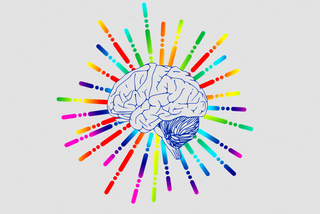Genetics
The Neuroscience of Genes and Alzheimer's Neuroinflammation
Discovery of genomic “crosstalk” with brain inflammation in Alzheimer’s disease.
Posted July 11, 2019 Reviewed by Devon Frye

In a breakthrough study published today in the neuroscience journal Neuron, researchers at Massachusetts General Hospital identified how the genes associated with neuroinflammation interact—findings that may one day lead to novel medical treatment for Alzheimer’s disease (AD).
Alzheimer’s disease is a degenerative brain disease that impacts memory, cognition and language. It is the most common type of dementia according to the CDC (Centers for Disease Control and Prevention). Eventually, this devastating disease can progress to a point where the patient is unable to perform bodily functions such as walking and swallowing due to neuronal death or damage.
The World Health Organization estimates there are 50 million people worldwide with dementia, with Alzheimer’s Disease contributing to sixty to seventy percent of cases. In the U.S., there are an estimated 5.8 million living with Alzheimer’s dementia in 2019, according to an Alzheimer’s Association report.
Senior author of the Neuron paper and neuroscientist Rudolph E. Tanzi, Ph.D., along with researchers Ana Griciuc, Marco Colonna, Joseph El Khoury, Suzanne E. Hickman, Ruslan I. Sadreyev, Anthony Anselmo, Danielle McGinty, Gea Cereghetti, Mary K. Oram, Brendan J. Innes, Se Hoon Choi, Anthony N. Federico, and Shaun Patel, aimed to understand what roles certain genes play in neuroinflammation associated with Alzheimer’s disease. The research team focused on two genes: CD33 and TREM2.
Prior neuroscience research studies have revealed over thirty genetic loci (positions on a chromosome) for Alzheimer’s disease—including many associated with microglia and the immune response such as CD33 and TREM2.
Microglia are the main immune cells of the central nervous system (CNS) that not only clear amyloid beta but also can release pro-inflammatory cytokines, the small secreted proteins that assist in cell to cell signaling, that result in neuroinflammation, the inflammation of nervous tissue. Amyloid beta is a peptide—molecules smaller than proteins consisting of two or more amino acids. Amyloid beta is the main component of amyloid plaques found in the brains of Alzheimer’s patients.
Eleven years prior, Tanzi and his research team discovered the association with CD33 and Alzheimer’s disease. CD33 contains the genetic code for microglia cell receptors, and cleans neurological waste such as tangles and plaques. Tanzi and fellow researchers made the discovery in 2013 that when CD33 is highly expressed, it can cause neuron damage by influencing microglia in a manner that triggers neuroinflammation.
CD33 acts as a neuroinflammatory trigger, and TREM2 acts on the reverse function by influencing the microglia’s ability to deactivate neuroinflammation. What, if any, interaction do the two genes have? In other words, is there any crosstalk between TREM2 and CD33?
To answer this question the researchers aimed to find out what happens when one or both of the genes CD33 and TREM2 are made inactive, or “knocked out.” Using Alzheimer’s disease mouse models, the research team generated single and double CD33/TREM2 knockouts.
The researchers discovered that knocking out CD33 restores cognitive function. Specifically, these mice performed better on retention memory and learning tasks and had less amyloid plaque in the brain than those where the CD33 gene was not made inactive. When TREM2 was subsequently knocked out in addition to the CD33, the positive effects stopped.
When the scientists knocked out TREM2 only, there was neuronal cell loss and neurodegeneration in the Alzheimer’s mice models. The cell loss did not stop when CD33 was also knocked out afterward. The team concluded that in modulating amyloid pathology, neurodegeneration, microgliosis, microglial gene expression, and cognition in Alzheimer’s mouse models, TREM2 acts downstream of CD33.
“Inhibiting CD33 and/or increasing TREM2 activity represent potential therapies for AD, e.g., by gene therapy, small molecules, or immunotherapy,” wrote the researchers in their report in Neuron. “Collectively, these data should greatly facilitate novel therapeutic approaches for the prevention and treatment of AD based on the modulation of microglial activation state.”
Through the interdisciplinary combination of genomics, molecular biology, immunology, statistics, chemistry, immunofluorescence microscopy, RNA purification, mRNA sequencing, and bioinformatics, scientists have illuminated a potential new avenue to future innovation in medicine in the treatment of Alzheimer’s disease.
Copyright © 2019 Cami Rosso All rights reserved.




